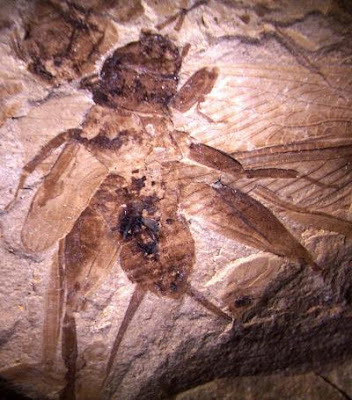Insects hear with help from unusual ears, said co-author Roy Plotnick of the University of Illinois at Chicago. Grasshoppers have ears on their abdomens. Lacewings have ears on their wings. The ears of the tachinid fly are tucked under the chin. "Insects have ears on pretty much every part of their body except on their head proper," Plotnick explained.
Insects have evolved ears at least 17 times in different lineages. Plotnick and co-author Dena Smith of the University of Colorado, Boulder are trying to figure out when different insects got their ears, and whether predators may have played a role.
Modern insects use their ears to tune in to each other's chirps, trills and peeps. Think of the chorus of crickets, or the love songs of cicadas. But many species can also pick up sounds beyond the range of human hearing, such as the high-pitched sonar of night-hunting bats. Crickets, moths and other flying insects have ultrasound-sensitive hearing and can hear bats coming, diving or swerving in midflight to avoid being eaten.
 |
| In crickets and katydids living today, the ear is a tiny oval cavity with a thin membrane stretched over it that vibrates in response to sound, much like our own eardrum [Credit: Dena Smith] |
"The big evolutionary trigger for the appearance of hearing in many insects is thought to be the appearance of bats," Plotnick said. "Prior to the evolution of bats we would expect to find ears in relatively few insects, but after that we should see ears in more insect groups," he explained.
Did insect ears get an upgrade when bats came to be? Before this study the fossil evidence for insect hearing was too poorly preserved or scantily described to know for sure.
To find out, Plotnick and Smith turned to remarkably well-preserved fossils from a series of lake deposits in Wyoming, Utah and Colorado known as the Green River Formation, where some of the earliest bats are found.
Roughly fifty million years ago, fine-grained sediment covered and buried the animals that lived there and managed to preserve them in exquisite detail. "You can see every tiny feature down to the veins in their wings and the hairs on their legs," said Smith, who has been studying Green River fossils for more than 15 years.
 |
| The ear appears as a light-colored oval on the front leg, just below the "knee" [Credit: Specimen number 30868 from the National Museum of Natural History; Photo courtesy of Roy Plotnick] |
The team scoured more than 500 museum drawers of Green River fossils for crickets and katydids with intact front legs, looking for evidence of ears. "You can just make them out with the naked eye," Plotnick said. "They look like the eye of a needle."
In crickets and katydids living today, the ear is a tiny oval cavity with a thin membrane stretched over it that vibrates in response to sound, much like our own eardrum.
The fossil ears measured half a millimeter in length, and were virtually identical in size, shape, and position to their modern counterparts.
The findings suggest that this group of insects evolved their supersensitive hearing long before bat predators came to be, the researchers say.
"Their bat-detecting abilities may have simply become apparent later," Smith said.
"The next step is to look for ears in other insect groups," she added.
Source: National Evolutionary Synthesis Center (NESCent) via EurekAlert! [January 02, 2012]






